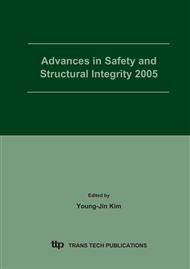p.3
p.9
p.15
p.23
p.31
p.39
p.45
p.55
p.63
Excavation-Induced Buried Pipeline Failure – A Case Study
Abstract:
This paper presents a case history involving a failure of water pipeline due to a deep excavation. The case history was analyzed using both the simplified method and more sophisticated finite element modeling. Also presented are the fundamentals of damage assessment of buried pipelines associated with deep excavation-induced ground movements. A number of ground displacement profiles pertinent to the damage assessment are introduced. The results of the analysis indicated that the excessive ground movement was the major cause for the failure. These results were partly supported by the finite element analysis which takes the soil-pipe interaction effect account. It is demonstrated that although conservative, the simplified approach presented in this paper can be effectively used as a first-order method for excavation-induced pipeline damage.
Info:
Periodical:
Pages:
23-30
Citation:
Online since:
March 2006
Authors:
Price:
Сopyright:
© 2006 Trans Tech Publications Ltd. All Rights Reserved
Share:
Citation:


